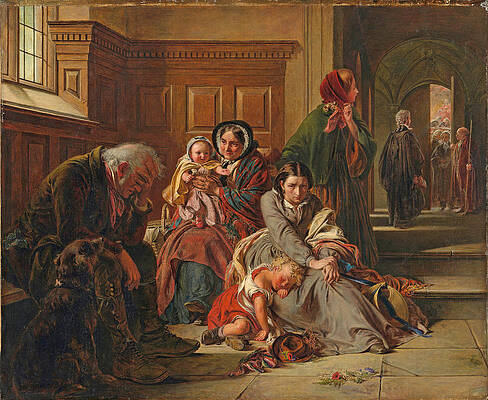Abraham Solomon
Second Class, The Parting. Thus part we rich in sorrow, parting poor

Waiting for the Verdict
Not Guilty
The Valour of Love
First Class, The Meeting. And at first meeting loved
Abraham Solomon (London 7 May 1823 – 19 December 1862 Biarritz) was an English painter.
Life
(Travelling) First Class - The Meeting (revised version). The original version was in the Victorian era considered as too controversial.
Born as the second son of Meyer Solomon, a Leghorn hat manufacturer, by his wife Catherine, in Sandys Street, Bishopsgate in east London. His father was one of the first Jews to be admitted to the freedom of the city of London. Two members of the family besides Abraham became artists. A younger brother, Simeon Solomon, acquired much acclaim as a Pre-Raphaelite painter and exhibited at the Royal Academy from 1858 to 1872; his later crayon drawings of idealised heads are still popular. A sister, Rebecca Solomon, exhibited domestic subjects at the Royal Academy and elsewhere between 1851 and 1875, and died on 20 November 1886.
At the age of thirteen Abraham became a pupil in Sass's school of art in Bloomsbury, and in 1838 gained the Isis silver medal at the Society of Arts for a drawing from a statue. In 1839 he was admitted as a student of the Royal Academy, where he received in the same year a silver medal for drawing from the antique, and in 1843 another for drawing from the life.
Solomon died in Biarritz in France, of heart disease, on 19 December 1862, the same day on which he was elected an Associate of the Royal Academy.[1] He married, on 10 May 1860, Ella, sister of Dr. Ernest Hart; she survived her husband.[2]
Works
The Acolyte, 1842. Oil on canvas
His first exhibited work, Rabbi expounding the Scriptures, appeared at the Society of British Artists in 1840, and in the following year he sent to the Royal Academy My Grandmother[3] and a scene from Sir Walter Scott's Fair Maid of Perth. These were followed (at the Academy) by a scene from the Vicar of Wakefield in 1842, another from Crabbe's Parish Register in 1843, and a third from Peveril of the Peak in 1845. The Breakfast Table, exhibited in 1846, and a further scene from the Vicar of Wakefield in 1847, attracted some attention.
In 1848 appeared A Ball Room in the year 1760, and in 1849 the Academy for Instruction in the Discipline of the Fan, 1711, both of which pictures were distinguished by brilliancy of colour and careful study of costume. Too Truthful was his contribution to the exhibition of the Royal Academy in 1850, and An Awkward Position—an incident in the life of Oliver Goldsmith—to that of 1851. In 1851, also, he sent to the British Institution Scandal and La petite Dieppoise.
In 1852 appeared at the Academy The Grisette and a scene from Molière's Tartuffe—the quarrel between Mariane and Valère, where Dorine interferes—and in 1853 Brunetta and Phillis, from the Spectator. In 1854, he sent to the Academy First Class: the Meeting, and 'Second Class: the Parting. Both were engraved in mezzotint by William Henry Simmons, and marked a great advance in Solomon's work. They show an originality of conception and design which is not apparent in his earlier work. His next contributions to the Royal Academy were A Contrast in 1855, The Bride and Doubtful Fortune in 1856, and Waiting for the Verdict in 1857. The last picture greatly increased his popularity; but its companion, Not Guilty, exhibited in 1859, was less successful. Both became the property of C. J. Lucas, esq., and were engraved by W. H. Simmons. The Flight, Mlle. Blaiz, and The Lion in Love (also engraved by Simmons) were exhibited at the academy in 1858; Ici on rase, Brittany and The Fox and the Grapes in 1859; Drowned! Drowned! in 1860; Consolation and Le Malade Imaginaire in 1861; and The Lost Found in 1862. Art Critics in Brittany appeared at the British Institution in 1861.
His last work, Departure of the Diligence at Biarritz, is now at the Royal Holloway College, Egham.[2]
References
Brian Stewart & Mervyn Cutten (1997). The Dictionary of Portrait Painters in Britain up to 1920. Antique Collectors' Club. ISBN 1 85149 173 2.
Graves, Robert Edmund (1897). "Solomon, Abraham". In Lee, Sidney. Dictionary of National Biography. 52. London: Smith, Elder & Co. "sources: [Art Journal, 1862 pp. 73–5, 1863 p. 29; Redgrave's Dictionary of Artists of the English School, 1878; Royal Academy Exhibition Catalogues, 1841–62; British Institution Exhibition Catalogues (Living Artists), 1851–61; Exhibition Catalogues of the Society of British Artists, 1840–3.]"
DNB, 1900. "now belonging to a cousin"
Attribution
"Solomon, Abraham". Dictionary of National Biography. London: Smith, Elder & Co. 1885–1900.
External links
Abraham Solomon artwork database and exhibition history
----
Fine Art Prints | Greeting Cards | Phone Cases | Lifestyle | Face Masks | Men's , Women' Apparel | Home Decor | jigsaw puzzles | Notebooks | Tapestries | ...
----
Artist
A - B - C - D - E - F - G - H - I - J - K - L - M -
N - O - P - Q - R - S - T - U - V - W - X - Y - Z
Retrieved from "http://en.wikipedia.org/"
All text is available under the terms of the GNU Free Documentation License






